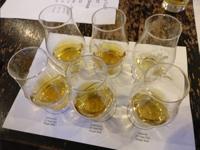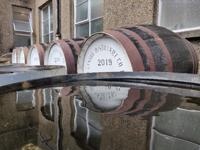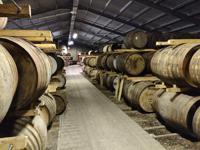Whisky Fundamentals
In principle, Scotch, Bourbon or Irish Whisky hardly differ in terms of production. While the raw materials differ slightly for the different types of whisky, all whisky is made using grain, water and fermentation by yeast. Malt whiskys are produced from malted barley, grain whiskys from cereals such as wheat, rye or oats and bourbon whiskies predominantly from corn.
Yet important differences can be found in the distillation technology used. Scottish malt whiskies have to be distilled in copper stills (pot stills), while large column stills are used for grain and bourbon whiskies. Further differences in whisky production can be found in the storage in oak barrels. Barrels from bourbon and sherry production are generally used for Scottish whisky, while only charred virgin American oak is permitted for bourbon whisky. In addition to the influence of the different whisky barrels, different barrel sizes also have an influence on the later taste of the whisky.
Latest Articles
Getting to grips with the basics of whisky is not essential to selecting and enjoying your next bottle, but the varied history and produciton methods are fascinating and can help guide you on your journey.

Slàinte Mhath - Pronunciation, Definition & Meaning
Published 15/09/2023
The Scottish Gaelic language is one of the Celtic languages and is spoken today only in parts of Scotland, mainly in the Hebrides, in the Scottish Highlands and partly in Glasgow. Scottish Gaelic is also closely related to Irish and the almost extinct language Manx (traditionally spoken on the Isle of Man). Along with English and Scots Gaelic is one of the offical languages of Scotland. Anyone who spends any time around Scotch Whisky will inevitably come across the greeting Slàinte Mhath (Slanj-a-va or slanschewaa) eventually.
Slàinte Mhath - Pronunciation, Definition & Meaning
Whisky and Food Pairing: A Match Made in Heaven
Published 15/09/2023
Whisky, a beverage rich in nuances and flavors, offers a wide array of pairing possibilities with various foods, transforming ordinary meals into gourmet experiences. Whether you are a whisky aficionado or a newcomer eager to explore, this guide will help you navigate the delightful world of whisky and food pairings. The most important thing to consider before you get started is how each course must balance but also fall on to each subsequent dram.
Whisky and Food Pairing: A Match Made in Heaven
Phenols
Published 14/09/2023
What are phenols? Phenols are chemical compounds that are of great importance for flavoring and flavor enhancement in the whisky industry, more commonly known as peat. Phenols are given on a technical scale in parts per million (PPM). This is a millionth unit that is also used in technical devices such as smoke extraction systems to check the air quality. These substances are important flavor carriers in the whisky industry, in particular distilleries from the Island of Islay and the Scottish Highlands known for their intense smoke note.
Phenols
The role of water in whisky
Published 14/09/2023
Water plays several important roles in the production of whisky. Firstly, water is used to clean and prepare the grains used to make the whisky. Second, it is mixed with the mashed grains to extract the sugars that will be fermented to create alcohol. Finally, water is used to reduce the alcohol content of the whisky to its desired strength. Additionally, water can help to bring out the flavours and aromas of the whisky when it is diluted before drinking.
The role of water in whisky
The types of wood used in the whisky inudustry
Published 12/09/2023
The art of whisky production leverages a rich variety of wood types and cask histories to craft spirits with unique and complex flavor profiles. While oak remains a staple in the industry, distillers around the world are increasingly experimenting with alternative woods such as chestnut, maple, acacia, mizunara and cherry to infuse their whiskies with distinctive notes and aromas. In general these are used for finishing spirit already matured in oak casks, but full maturation examples of the same do exist more commonly coming from independant bottlers.
The types of wood used in the whisky inudustry
